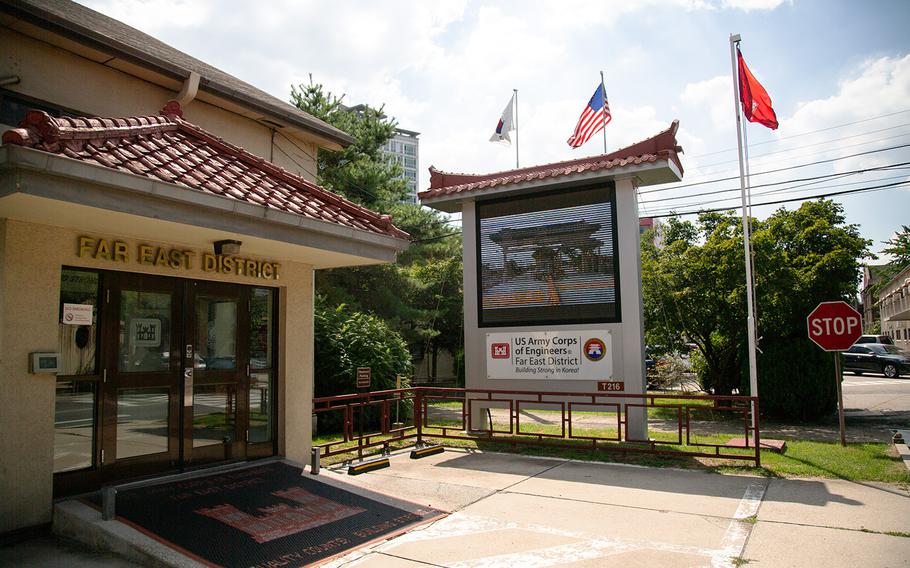
Know as FED, this compound in Seoul, South Korea, has been home to the U.S. Army Corps of Engineers, Far East District, headquarters since the 1950-53 Korean War. (Marcus Fichtl/Stars and Stripes)
SEOUL, South Korea — A few blocks from the sloping, spaceship-shaped Dongdaemun Design Plaza in one of Seoul’s trendiest fashion districts is another odd sight.
A tiny U.S. Army base sits just across the street from a hospital morgue and adjacent to a park that blocks its view from a major thoroughfare.
Known as FED, the compound has been home to the U.S. Army Corps of Engineers, Far East District, headquarters since the 1950-53 Korean War. Before that it was the site of a Japanese-built school from the nearly four decades when Japan occupied the peninsula until its defeat in World War II.
Surrounded by walls topped with concertina wire, the 13-acre base can be easy to miss, one of several sub-installations that belong to the larger Yongsan Garrison just a few miles away.
But its history reflects the highs and lows of the U.S. presence in the South Korean capital. In a final act, the Corps of Engineers is preparing to close the base after it moves to Camp Humphreys as part of the long-delayed relocation of most U.S. forces south of Seoul.
Kenneth Pickler, 64, the Far East District’s transportation chief, has worked on the compound since he was first deployed there as a soldier 1989, then took a job as a civilian after retiring from active duty.
The Cloverdale, Calif., native plans to retire after the FED compound closes, although he plans to remain in South Korea.
“My last official duty is to shut off the lights, lock the gate and hand the keys over … back to the garrison,” he told Stars and Stripes in an interview last month. “And that’s supposed to happen in mid-November.”
Highs and lows
The tree-lined FED compound, which has nearly four dozen buildings, was once thriving with a population that reached a peak of about 700 when soldiers lived on the base. South Koreans and other visitors frequented the popular East Gate Club, with a bar and slot machines. The parking lot outside used to be a swimming pool.
Pickler recalled the Army club as a place where people celebrated weddings, St. Patrick’s Day and staged parades before it started losing money and closed in 2007.
Stars and Stripes’ Korea area office moved into the building some two decades ago. The newspaper relocated to Camp Humphreys last month.
Residents also used to have garden plots where many grew their own tomatoes and chili peppers. Only one remains.
The base, which has a motor pool and gas pumps, has faced environmental concerns in the past, but Pickler said the Americans resolved the problems and replaced aging equipment with leak-proof containers and pipes.
One of the worst incidents reportedly occurred in the early 1990s when South Koreans razed a Japanese courthouse outside the perimeter to turn the area into a park and underground parking garage.
“They didn’t shore up the land properly and the ground shifted,” damaging buildings and storage tanks with lines running underground, Pickler said. “We lost a couple thousand gallons of fuel oil. It went into that big pit out there.”
Local workers apparently pumped the toxic runoff into the storm drain instead of transporting it to a disposal unit, prompting nearby vendors to complain about the smell, Pickler said. “We remediated all of that.”
South Korea’s Environmental Ministry, which was created in 1994, and city officials said they lack records from that time period and couldn’t provide information about the incident.
Two unexploded bombs also were found in the area — one while they were digging for the park and another as crews were building a department store nearby, Pickler recalled.
Cultural legacy
The base was an eyesore in the increasingly prosperous area. It was the occasional target of protesters, including students who seized an American flag and burned a hole in it before being detained by Korean police in 2003, and South Korean contractors who were angry over not getting paid for work on the troubled Camp Humphreys expansion project in 2008.
About a third of the buildings on the compound were built by the Japanese, though the Americans added their own touches.
“The Japanese first constructed the Gyeongseong School of Education in 1922, which is currently the main building at FED,” according to a U.S. military installation handbook on cultural and natural resources.
The historic building has been expanded, the original entrance blocked and many of the bricks used for the original construction have been replaced, but the arch shape at the entryway, the stone foundation, stairs and arch-shaped windows remain, the 8th Army handbook says.
It’s unclear what will happen after the Corps of Engineers and other units on the base finally turn the property over to the South Korean government.
The transition that was supposed to take place in 2008 wasfrequently delayed due to Humphreys’ construction problems and other issues.
In 2008, Seoul National University, which originally owned the land before it was seized by the government at the start of the war, appealed to have the property returned so it could build a new science research center. But that plan appears to have fizzled over time.
The university’s public affairs office referred queries to the Ministry of National Defense and told Stars and Stripes that SNU has no plans to build any facilities on the property. Government officials said no plans have been set.
The base’s population, meanwhile, was down to about 214 last month and declining rapidly.
“We’ve been going to move to someplace since I got here in ‘89,” Pickler said. “But it’s finally happening.”
Stars and Stripes reporter Yoo Kyong Chang contributed to this report.
gamel.kim@stripes.com Twitter: @kimgamel